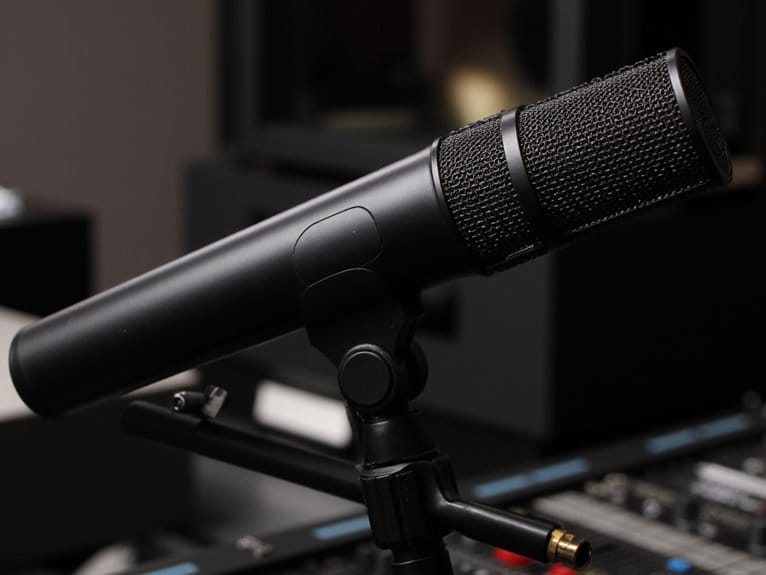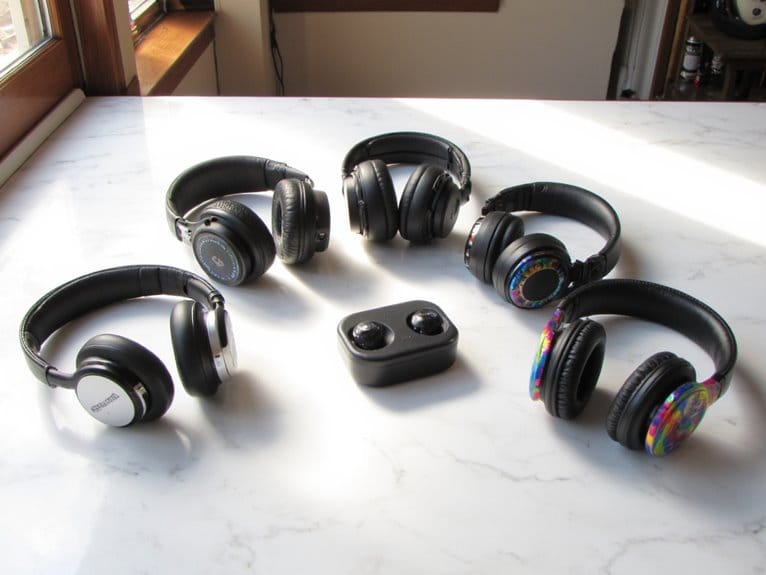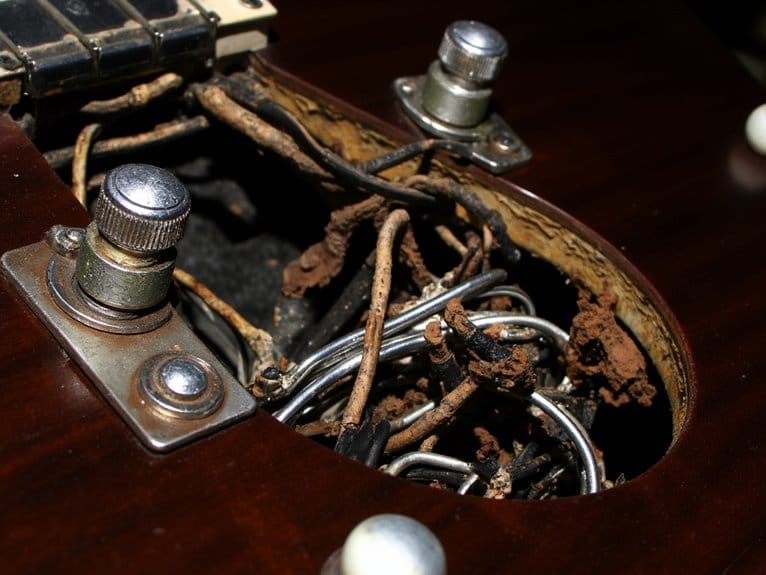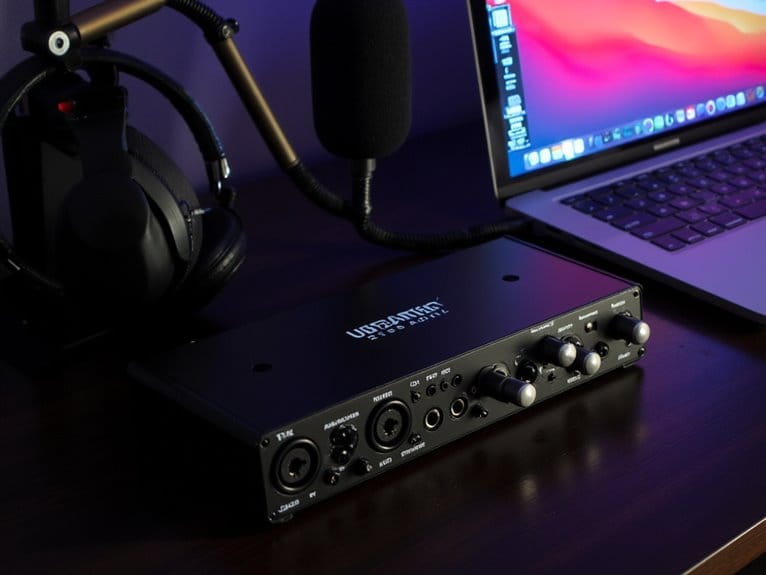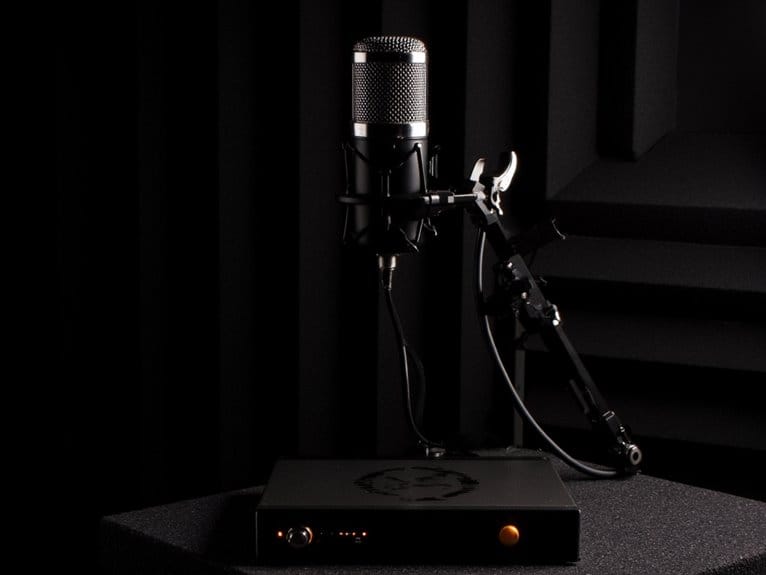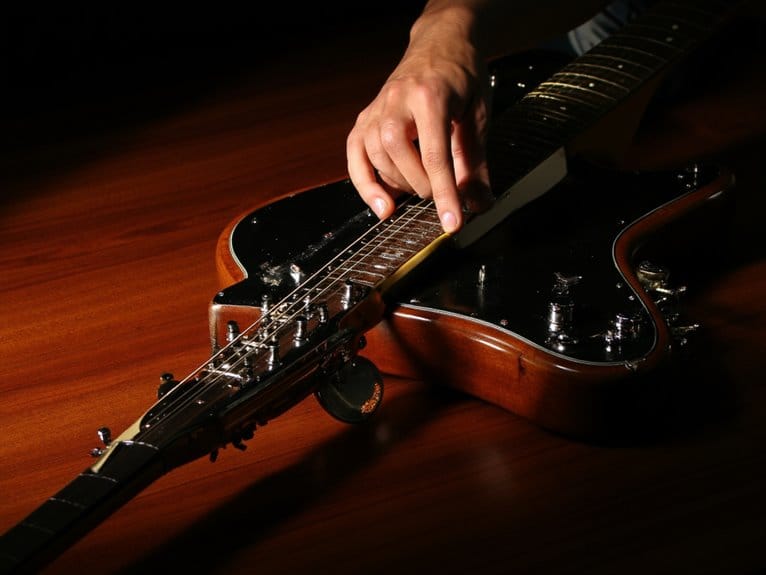Shotgun Microphones: How They Work and When to Use Them
You’ll find shotgun microphones work through their interference tube design, which allows on-axis sounds to pass directly while off-axis noise enters through slots, creating phase cancellation that rejects unwanted background audio. They’re essential for film dialogue, broadcasting interviews, and live events where you need focused sound capture from 3-4 feet away. Short shotguns offer portability, while longer models provide superior directional control and noise rejection, though they require boom poles for ideal positioning and cost considerably more for professional-grade performance.
We are supported by our audience. When you purchase through links on our site, we may earn an affiliate commission, at no extra cost for you. Learn more.
Notable Insights
- Shotgun microphones use interference tubes with slots to create phase cancellation, allowing on-axis sounds through while rejecting off-axis noise.
- The elongated tubular design with directional pickup patterns makes them ideal for isolating specific sound sources from background noise.
- Position shotgun mics 3-4 feet from subjects, angled slightly downward, preferably mounted on boom poles with shock mounts.
- Best applications include film dialogue, broadcasting, interviews, and live events where focused audio capture is essential.
- Choose based on size trade-offs: short mics for portability, long mics for superior directivity and noise rejection.
Understanding the Anatomy of Shotgun Microphones
When you first examine a shotgun microphone, you’ll immediately notice its distinctive elongated, tubular design that sets it apart from other microphone types, featuring a narrow build that extends from the tip all the way back to the capsule housing.
A shotgun microphone’s elongated, tubular form immediately distinguishes it from standard microphones with its unmistakable narrow design.
The slotted interference tube at the front creates the directional pickup pattern, while a protective grid wraps around it to prevent damage and minimize sound reflections. Side sounds must enter through slots, resulting in varied pathway delays that create phase interference.
Understanding microphone anatomy helps you appreciate how the diaphragm and backplate work together within the capsule to convert sound waves into electrical signals.
Proper capsule alignment relative to the interference tube is absolutely critical for achieving ideal phase cancellation, which gives shotgun mics their signature focused pickup pattern and exceptional off-axis rejection capabilities.
This design achieves a super-cardioid pattern that provides superior directional sensitivity compared to standard cardioid microphones.
The Science Behind Interference Tubes and Phase Cancellation
At the heart of every shotgun microphone‘s remarkable directional capabilities lies a deceptively simple yet ingenious acoustic device called the interference tube, which functions as a sophisticated sound filter that doesn’t rely on electronics or digital processing.
This slotted cylinder allows on-axis sounds to pass directly through while forcing off-axis sounds to enter through multiple slots at varying distances, creating different path lengths that generate phase cancellation effects.
When these off-axis sound waves arrive at the capsule out of phase, they partially cancel each other out, dramatically reducing unwanted ambient noise.
The interference tube design determines how effectively this acoustic filtering works, with factors like slot spacing, tube length, and material density all influencing the microphone’s directional performance and frequency response characteristics. For optimal audio capture, professional shotgun microphones typically maintain a frequency response of 20Hz-20kHz to ensure accurate sound reproduction across the full spectrum of human hearing. The directional effectiveness typically diminishes significantly below 2kHz, where the interference tube’s acoustic filtering becomes much less effective than at higher frequencies. However, many products labeled as shotgun microphones lack true directional pickup patterns and perform more like standard cardioid or super-cardioid microphones despite their marketing claims.
Supercardioid Polar Patterns and Directional Control
The supercardioid polar pattern represents a significant step up from standard cardioid microphones in relation to directional control, offering you a much tighter pickup angle that’s perfect for isolating specific sound sources in challenging acoustic environments.
The supercardioid advantages include stronger background noise rejection and enhanced focus on your intended target, making them ideal for film production and broadcast work where precision matters.
However, rear lobe considerations require careful positioning since these mics pick up some sound from directly behind at 180 degrees, unlike cardioids that completely reject rear sounds.
Unlike cardioids, supercardioid mics require strategic positioning due to their rear pickup lobe at 180 degrees.
You’ll find null points at roughly 127° and 233°, which means strategic placement becomes essential when working in multi-microphone setups to avoid unwanted bleed and maintain that clean, professional sound isolation you’re after. This directional characteristic makes supercardioids particularly effective in high-noise environments where you need to cut through ambient sound and focus solely on your primary audio source.
Understanding these polar pattern charts helps you visualize the exact sensitivity zones and make informed decisions about microphone positioning for optimal recording results.
Short Vs Long Vs Super Shotgun Microphone Types
When you’re choosing a shotgun microphone, you’ll quickly discover that length isn’t just about fitting into your gear bag—it fundamentally determines how the mic performs in different recording scenarios.
I’ve found that short shotguns, ranging from 4 to 6 inches, offer excellent portability for handheld work but sacrifice some directional precision.
On the other hand, long shotguns at 9 to 12 inches provide superior off-axis rejection that’s vital for boom operation, and super shotguns extend even further for extreme long-distance capture.
The trade-off you’re making is basically between convenience and performance, since longer interference tubes create better directivity but demand more physical space, support equipment, and can introduce subtle frequency coloration that shorter models avoid. The interference tube runs from the microphone capsule to create an acoustic labyrinth that produces the characteristic lobar polar pattern. Medium shotguns strike a balanced compromise for booming applications and voice pickup when you need manageable handling without sacrificing too much directional control.
Range and Application Differences
While shotgun microphones share the same fundamental interference tube design, their varying lengths create distinct performance characteristics that I’ve found dramatically affect their practical applications in different recording scenarios.
Short shotguns excel in controlled indoor environments where you’re capturing close-range dialogue, offering excellent shotgun microphone benefits while maintaining manageable size for handheld work.
Long shotguns provide enhanced directional pickup for medium-distance subjects, making them ideal for field recording and broadcast applications where sound isolation techniques become critical.
Super shotgun microphones deliver the tightest directional control, perfect for extremely noisy environments like crowded press conferences or outdoor events. These designs utilize destructive wave interference to achieve their enhanced directional capabilities by canceling off-axis sound components that arrive at different times.
Despite common misconceptions, longer shotguns don’t actually extend your microphone’s reach—they simply improve clarity by rejecting more ambient noise. The most critical factor when selecting between these types should be audio quality, as this determines the professional usability of your recordings regardless of the specific shotgun length you choose.
Physical Size Trade-offs
Understanding the physical trade-offs between short, long, and super shotgun microphones has become essential in my work, since each size category brings distinct advantages that directly impact your recording quality and practical workflow.
When comparing short vs medium shotguns, you’ll find that compact models excel in portability considerations, fitting seamlessly on cameras for run-and-gun filming, while medium variants require XLR connections but deliver superior directional performance up to six feet.
Long shotguns offer the highest noise rejection through extended interference tubes, though they demand boom poles and careful handling due to their weight and bulk.
The fundamental trade-off remains consistent: compactness with reduced isolation versus greater selectivity with increased size constraints, forcing you to prioritize between mobility and acoustic performance.
Directivity Performance Comparison
Everything changes when you compare directivity performance across shotgun microphone categories, since the fundamental physics of wave interference creates dramatically different pickup patterns that’ll directly affect your recording results.
Understanding the directivity impact and frequency influence across different shotgun types helps you choose the right tool:
- Short shotgun mics offer wider acceptance angles with moderate directivity, making them forgiving for slight aiming errors but less effective at isolating sound sources.
- Long shotgun mics provide considerably higher directivity with narrower pickup patterns, delivering better ambient noise rejection through enhanced phase cancellation.
- Super shotgun mics achieve the tightest polar patterns and highest directivity index, excelling at distance capture but requiring precise aiming.
- Frequency response varies considerably, with longer tubes lowering the corner frequency where directivity begins increasing.
Prime Applications in Film, Broadcasting, and Live Events
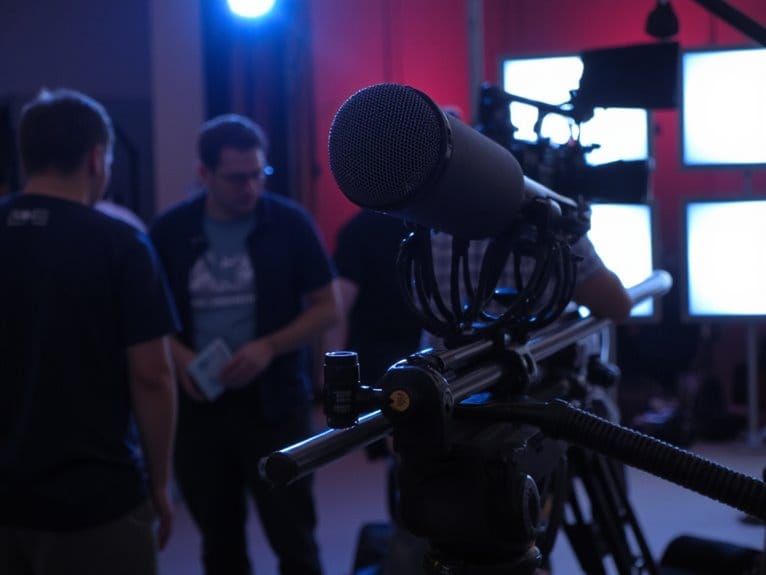
You’ll find shotgun microphones dominating three critical industries where precise audio capture can make or break a production, and honestly, I’ve witnessed firsthand how these directional workhorses solve problems that would otherwise require expensive post-production fixes.
Whether you’re capturing dialogue on a bustling film set where ambient noise threatens to muddy every line, conducting interviews in chaotic broadcast environments where crowd chatter competes with your subject’s voice, or managing live events where hundreds of conversations create an acoustic nightmare, shotgun mics provide the focused pickup pattern that separates professional results from amateur recordings.
The beauty lies in their ability to isolate your intended audio source while rejecting off-axis noise, fundamentally giving you surgical precision in environments where traditional microphones would capture everything within a wide radius.
Film Dialogue Isolation
Three fundamental positioning techniques separate amateur boom operators from experienced professionals when it comes to capturing pristine dialogue on film sets. I’ve seen countless productions struggle with basic microphone placement that could’ve been avoided with proper shotgun mic methodology.
Your positioning strategy directly impacts dialogue clarity and background noise rejection. Here’s what works:
- Angle from Above: Position the shotgun mic overhead, pointing downward toward the speaker’s mouth to maximize off-axis sound rejection.
- Maintain Line of Sight: Create a direct path between the microphone and the actor’s mouth while staying just outside the camera frame.
- Leverage Side Rejection: Exploit the shotgun’s natural tendency to attenuate sounds from its sides, positioning ambient noise sources off-axis.
- Minimize Gain Adjustments: Proper placement reduces the need for increased gain levels that introduce unwanted environmental noise.
Broadcasting Interview Clarity
Broadcasting transforms ordinary conversations into compelling content, but I’ve watched too many promising interviews collapse under the weight of background chatter, traffic noise, and ambient chaos that could’ve been tamed with proper shotgun microphone technique.
When you’re capturing live interviews, shotgun mics become your audio lifeline, using their highly directional pickup patterns to isolate your subject’s voice while rejecting surrounding distractions.
Their interference tubes narrow the sound field through phase cancellation, which I’ve found essential during street interviews where ambient noise threatens clarity.
You’ll appreciate how these mics let you maintain social distancing while capturing broadcast-quality audio, and their robust design handles the unpredictable nature of field reporting where effective interview techniques can make or break your story.
Live Event Focus
While interviews demand precision and control, live events throw every audio challenge imaginable at you simultaneously. I’ve learned that shotgun microphones become absolutely indispensable when you’re trying to capture clean sound amid the chaos of crowds, amplified music, and unpredictable ambient noise.
For sound quality optimization across different live audience dynamics, I rely on these specific applications:
- Concert broadcasts – capturing performer vocals while rejecting overwhelming crowd noise and stage monitors
- Sports commentary – isolating sideline interviews from stadium roar and PA announcements
- Festival documentation – recording clear dialogue between multiple stages with competing audio sources
- Award ceremonies – maintaining speech intelligibility despite applause, music cues, and audience chatter
Their interference tube design cancels off-axis sounds effectively, delivering broadcast-quality audio even when positioned at considerable distances from subjects.
Optimal Positioning and Mounting Techniques
Getting the most out of your shotgun microphone isn’t just about having the right equipment—it’s about positioning it correctly, and I’ve seen countless recordings ruined by poor placement decisions that could’ve been easily avoided.
For ideal microphone isolation, position your shotgun mic 3-4 feet from your subject, angled slightly downward from eyebrow height toward the mouth or chin. This sound positioning technique maximizes the directional pickup pattern while minimizing off-axis noise.
Mount it on a boom pole with a shock mount—trust me, handling noise will kill your audio faster than background chatter. Keep the mic just outside your camera frame, pointing directly at your subject, and you’ll capture clean, professional dialogue every time.
Choosing the Right Shotgun Microphone for Your Project
After testing dozens of shotgun microphones across various production scenarios, I’ve discovered that selecting the right model depends on balancing your specific recording environment, budget constraints, and technical requirements with the inherent characteristics of each microphone’s design.
You’ll find entry-level models under $200 work adequately for basic projects, while mid-range options like the Sennheiser MKE 600 or RØDE NTG3 offer superior build quality and performance for most applications.
Budget considerations shouldn’t overshadow microphone compatibility requirements, particularly phantom power availability and XLR interface capabilities.
Professional models exceeding $800, including the industry-standard MKH 416, deliver exceptional directivity and durability for demanding productions, though they’re often unnecessary for casual creators.
Frequently Asked Questions
Do Shotgun Microphones Work Well in Windy Outdoor Conditions?
You’ll find shotgun microphones struggle with wind noise during outdoor recording unless you invest in proper protection.
While their directional pickup helps compared to omnidirectional mics, wind hitting the capsule creates substantial low-frequency interference that’ll overwhelm your audio.
I’ve learned that foam windscreens only handle light breezes up to 9 MPH, so you’ll need softies or blimp systems for serious outdoor work in windy conditions.
Can Shotgun Microphones Be Used Effectively for Recording Music Performances?
You’ll find shotgun microphones quite effective for live recordings when you need excellent sound isolation from ambient noise and crowd chatter.
I’ve noticed they work best for capturing soloists or small ensembles from a distance, keeping your stage uncluttered while delivering clean audio separation.
However, you shouldn’t expect the intimate sound quality that close-miking provides, and they’re less suitable for dense orchestral arrangements.
How Much Do Professional Shotgun Microphones Typically Cost?
When you’re doing price comparison for professional shotgun mics, you’ll find entry-level models ranging from $199-$299, while mid-range options sit between $300-$500.
I’ve noticed budget options around $150-$250 work for semi-professional use, though they sacrifice some build quality.
Premium models exceed $500, with top-tier choices pushing $1,000+, depending on features like dual-power operation, advanced polar patterns, and included accessories.
What Accessories Are Essential When Using Shotgun Microphones?
You’ll need shock mounts to eliminate handling noise and vibrations during handheld or boom pole recording, plus windshields—those furry “dead cats”—for outdoor wind protection that prevents distorted audio.
Quality XLR cables guarantee reliable signal transmission, while adjustable mounting brackets provide proper microphone positioning relative to your sound source.
I’d recommend including protective cases for transport.
Do Shotgun Microphones Require Phantom Power to Operate Properly?
Most shotgun mics you’ll encounter are condenser types that absolutely require 48V phantom power to function, and without it, you’re getting zero audio quality since they won’t operate at all.
I’ve learned that your camera, recorder, or mixer typically supplies this power through XLR cables, though some models offer battery backup options for situations where phantom power isn’t available.
On a final note
You’ve now got the technical foundation to make informed decisions about shotgun microphones, though I’ll admit the interference tube physics can still make my head spin sometimes. Whether you’re capturing dialogue on a film set, recording wildlife sounds, or managing live events, you’ll find these directional workhorses invaluable when you need precise audio capture. Choose wisely based on your specific distance requirements, environment constraints, and budget considerations for ideal results.

